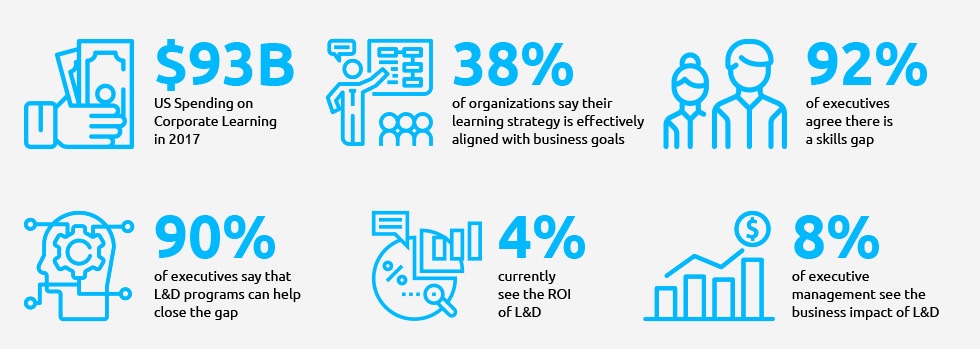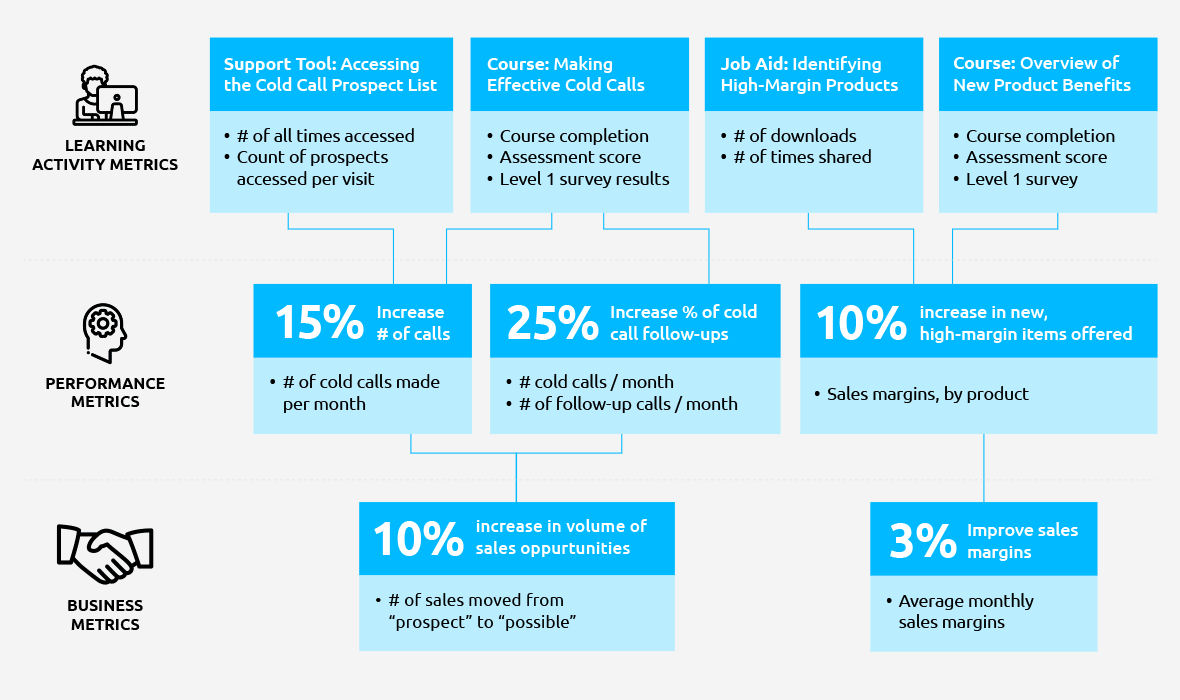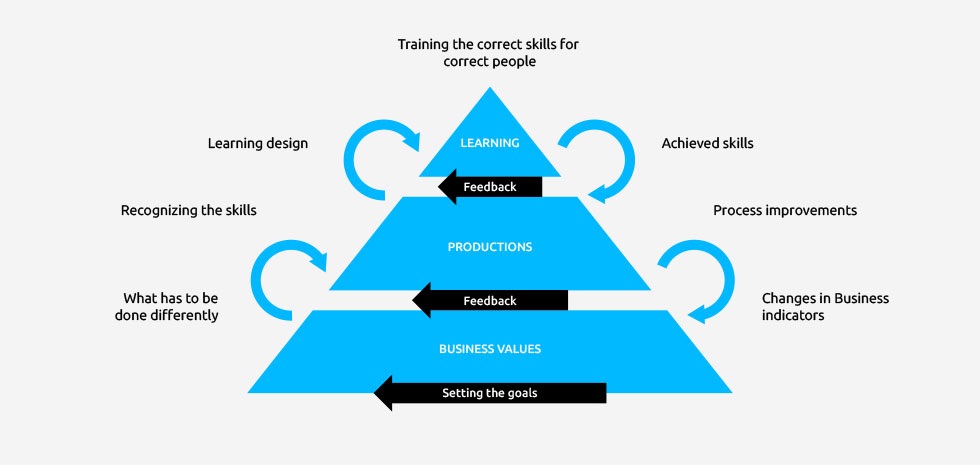How do you align your corporate learning strategy with your business strategy?
Discover the importance of learning impact in every corporate learning strategy. Learn how to improve performance to reach business goals.

In 2017, US spending on corporate learning grew to more than 93 billion dollars and yet, only 38% of organizations in Brandon Hall Group’s latest research survey say their learning strategy is effectively aligned with business goals. To further this point, 92% of executives agree there is a skills gap in the US workforce and 90% of executives say that Learning and Development (L&D) programs can help close the gap.
This massive investment in corporate learning is a testament to the fact that executives see the value in corporate learning, but there are critical issues when it comes to strategy, execution, and understanding of learning impact.

So far, we know this to be true:
Reasons to invest in corporate learning
- Motivate Employees: Offering learning and development to employees establishes company loyalty and commitment and motivates employees
- Close the skill-gap: reskill employees that already understand the company (and how to apply information learned) rather than spending money on higher salaries for new employees with new skills.
- Organizational Agility: Pivot an organization faster and more efficiently.
- Create a work culture of productivity: The change that is powered by knowledge and learning in a company is called learning impact. Work becomes more meaningful and relevant.
- Positive impact on business goals: When processes become more fluent and efficient, business results like turnover are better. This is called business impact.
What is the learning impact?
The learning impact occurs when a training-acquired, strategically meaningful skill is applied to improve performance in some part of a job that produces a result that contributes to a business goal.
Learning is consumed on an individual basis, begins to add value when it is retained, adds further value when the individual takes it back to the workplace and adds more value when it is integrated into the larger team performance. When an individual learns more, they will increase the performance of the entire team. Learning new things will create new value not only for the learner, but also their coworkers, departments and the entire company. This is called the knowledge value chain.
The learning impact is the most vital (but often missed) value-add in every learning and development strategy.
Chasing ROI is important for many executives, but ROI is only one small portion of the value that learning impact can bring.
In order to ensure you hit your learning impact target, begin with these steps.
The Impact Map: Steps to succeed with the Learning Impact
- Define business goals and metrics of success
- Determine learning strategy: Performance metrics & learning activities
- Outline reporting and analysis plan
- Adjustment action plan
Let’s go through steps 1 to 4 in more detail.
1. Define business goals and metrics of success
“What is the highest value at stake and most urgent issues that leadership must address to close the gap between its ambition and the company’s current trajectory?”
– Michael Mankins, Harvard Business Review: 5 Ways the Best Companies Close the Strategy-Execution Gap
It is crucial to work closely with the executive team to understand business goals and metrics of success, as well as what problems affect those business goals. To put it simply, a metric of success is a measurement people care about; a measurement perceived to add value to the company and aid in achieving business goals. If you clearly know the prioritization for metrics of success, it will be easier for you to align learning strategy with business strategy, and even easier for you to track, measure and communicate the learning impact.
3 Common examples of success metrics in an L&D strategy
- A very common metric of success is to increase ROI. This requires you to define more specific metrics that will result in increased ROI. Let’s say a Human Resources executive mentions that the current employee turnover rate is higher than the industry average. Research shows that the cost of replacing an employee is 50% to 250% of their annual salary and benefits. There are costs associated with pre-departure, recruiting, selection, training and productivity loss. You can deduct that reducing turnover can be an initiative to yield a higher ROI.
- Similarly, another way that organizations can improve their ROI (and other KPIs) with a proper learning and development strategy is by increasing employee engagement. Gallup studies show that in the U.S., approximately 17.2% of the workforce is actively disengaged. Disengagement presents itself in the form of tardiness, missed work-days, and decreased productivity. Gallup estimated that a disengaged employee costs an organization approximately $3,400 for every $10,000 of salary, or 34%.
- “10% increase in the volume of sales opportunities.” This is an example of a clearly defined business metric of success, that will help achieve bigger company objectives.
These are just a few examples of many metrics, that can result in achieving your success metrics. Other issues commonly alleviated by a well-executed L&D strategy include:
- optimizing training delivery
- generating and storing data
- tracking compliance
- growing leadership
- improving customer service
- driving company culture
- increasing engagement
- building community
- increasing sales
- creating transparency
- building an online academy
- increasing safety
- reducing turnover
There are so many metrics, but how do you prioritize which metric is most important?
Collect insights from ALL stakeholders
If a learning strategy is going to be effective, the process needs to impact goals and needs to be easily communicated, and often. Understand issues in every branch of your business to better capitalize on learning. Meet with employees from all departments to understand issues in workflows, development and the onboarding process. Create a culture of learning by addressing the needs of employees. Most companies fail to create a culture of learning by failing to include all members at the table when discussing L&D strategy.
- 81.8% of organizations only have cross-departmental discussions around training, employee development or skill-building on an as needed basis, quarterly, or less.
- Only 8% currently see the business impact of L&D.
2. Determine learning strategy: Performance metrics & learning activities
Now that you have prioritized your business metrics by collecting insight from stakeholders, how do you implement a learning strategy that will address those concerns?
There is ample research on how to influence behavior by means of design and language in fields like marketing, advertising, language. In the famous book, How to Win Friends and Influence People, Dale Carnegie was one of the first people to address influencing behavior to create performance-based training with his core principle being, “Arouse in the other person an eager want,” which we have come to define as “engagement.”
Marketing and sales teams use tools like a CRM to measure performance metrics such as engagement statistics: open rate and click-through-rate, or the number of calls and sales cycle length. Whereas corporate learning uses tools like learning experience platforms (LXP) and learning management systems (LMS) to track learning metrics such as employee engagement.
Employee engagement is measured via statistics like the completion of courses, employee satisfaction surveys, time spent on an assignment which is then tracked in the Learning Record Store (LRS). This makes it possible to identify learning styles and preferences to content in order to optimize the learning experience and increase performance. Learning analytics help identify and understand diverse learning styles so you can design more efficient training courses based on specific learning needs. You can identify and distribute learning content by role, learning style, expertise, and other categories.
Learning experience platforms using predictive analytics and data science help you better understand your business, the relationship between business and knowledge/learning, make better business and training decisions, analyze trends, and predict future business outcomes.
Learning analytics framework

What content do you deliver?
The content you deliver all depends on the individuals at your company and you must be ready to trial, measure, evaluate the effectiveness of your content and adjust the content. No process is constant because environments change constantly, especially when disruptive technology shakes things up. Taking a deeper look at how learners actually proceed in their studies tell you a lot about our learning content. Do they have problems passing quizzes? Do they systematically skip some parts? What are the most consumed materials? Ideally, the content is built with a specified skills metrics in mind. E.g. Bloom’s taxonomy offers a great framework to support the skills development and building the learning content.
Evaluating if your content really takes our learner’s to the next level will help you achieve our L&D goals and see the results even in ROI. To make sure our content is good quality but also reachable, we need to consider the most effective ways to keep learners’ attention. Luckily, there are a few trends that have shown promising results towards mobile-friendly content that adopts AI chatbots, microlearning, social learning, video learning and gamification.
3. Outline reporting and analysis plan
You should decide on the measurable indicators of the learning. This can be e.g. some KPI, a level of security issues, money spent in L&D yearly, faster processes, etc. You should already have a reporting and analysis plan in place before implementing your learning strategy so that you can quickly make adjustments based on the data received in real-time.
Prepare If-Then statements based on what metrics you are tracking or implement intelligent automation to utilize adaptive content that will adjust content automatically.
For example:
If X happens, then adjust Y.
If people are skipping through video content, or not finishing courses, then the content should be changed.
If the average session time in the learning environment in 10 minutes, then create easier to absorb microlearning modules instead of longer and deeper lessons which require more time.
Other questions that should be answered to analyze the learning impact are explicated in Bersin’s Impact Measurement Framework — Bersin’s framework identifies 9 measurement areas to consider to achieve an integrated measurement program:
- Adoption
How well did you reach the desired audience? - Utility
How useful was it? - Efficiency (Financial measures)
Financial measures: What was the cost to develop versus the cost per learner? Compare against industry averages. - Alignment
How well were the business goals defined? - Attainment (of customer objectives)
How well do you meet the specific program and budgetary objectives of your customer? - Satisfaction
How well did the learners like content, delivery, experience, and nature of the program? - Learning
Does this learning directly correlate to the root cause of the business problem? - Individual Performance
How well are the individual performance objectives, defined upfront, met by the program? - Organizational Performance
How well are the general business or HR measures affected by the program?
Communication with stakeholders
Plan to communicate results with the defined stakeholders (executives, learners, HR) and receive feedback. The more clearly you communicate the achieved results by reports and graphs, the easier it is to see the progress and the influence that has been made in the business; ROI, employee satisfaction, whatever the defined goal may be. Business goals can sometimes shift, employees may express opinions as to why they didn’t like the content or what skills they would like to develop.It is also important that stakeholders see progress on a routine basis, and understand the changes that have been made and why.
4. Adjustment action plan
A thorough strategy should not only be planned and executed but rather planned, executed and adjusted. In the diagram below, you can see a feedback loop of adjustment and action. Begin at the bottom by setting your business goals. Receive feedback on what needs to be different, and what skills are needed to achieve the necessary business goals.
Once you know what skills are needed, you can begin to create learning content dedicated to training people to acquire those skills. You can track with a learning platform who has achieved certain skills, who is struggling with the content, and you can adjust the content to better serve employees by receiving feedback from people who have struggled and people who have excelled.
Over time you will see if any changes have occurred in productions and performance. If people that have achieved certain skills don’t have any improvement in performance, you can use that feedback and adjust the learning content. If you have seen performance changes, you will also begin to see improvements in your business indicator measurements. You can begin to set new goals, and the process begins again.

Harvard Business Review stated that “the best companies see strategy less as a plan and more as a direction and agenda of decisions. There are huge rifts in strategy, execution, and performance and in today’s fast-paced world, the ‘cone of uncertainty’ surrounding the future market and competitive conditions.” The emergence of new disruptive technology requires organizational agility to be a high priority.
“An investment in knowledge pays the best interest.”
-Benjamin Franklin




